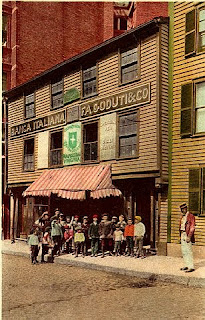 The New England Confectionery Company was formed in 1901 when three pre-Civil War candy companies merged. Chase & Company, Hayward & Company, and Wright & Moody, all founded in the 1840s and 1850s, joined forces and built a huge manufacturing plant in Boston at the corner of Summer and Melcher, along the Fort Point Channel. (I would imagine it was located somewhere near the intersection of what are now Necco Street and Necco Court--I'll investigate on my next trip to Boston!)
The New England Confectionery Company was formed in 1901 when three pre-Civil War candy companies merged. Chase & Company, Hayward & Company, and Wright & Moody, all founded in the 1840s and 1850s, joined forces and built a huge manufacturing plant in Boston at the corner of Summer and Melcher, along the Fort Point Channel. (I would imagine it was located somewhere near the intersection of what are now Necco Street and Necco Court--I'll investigate on my next trip to Boston!)When it was completed in 1902, the new plant was the largest factory devoted exclusively to confectionary manufacture in the US--it occupied four five-story buildings and took up five acres of floor space.
 Two of the first products to roll out of the new factory were Sweethearts Conversation Hearts and the newly-rechristened NECCO Wafers. Both were made from the same batter--the wafers (previously called Peerless Wafers) had first been introduced to the public in 1847 by Oliver Chase--whose premier accomplishment was the invention of a lozenge-cutting machine.
Two of the first products to roll out of the new factory were Sweethearts Conversation Hearts and the newly-rechristened NECCO Wafers. Both were made from the same batter--the wafers (previously called Peerless Wafers) had first been introduced to the public in 1847 by Oliver Chase--whose premier accomplishment was the invention of a lozenge-cutting machine. Sweethearts (previously known as Motto Hearts) had started out looking more like fortune cookies with a "motto" stuffed into a candy shell. Then Oliver Chase's brother, David, began experimenting with printing the sayings directly on the candies. In the new plant, the candies were rebranded and assumed the shape and size they still retain today.
By 1904, NECCO candies were sold in every U.S. state, as well as in England, Europe, Australia, and South America. And during 1904 and 1905, NECCO began advertising with display cards in magazines.
 In 1905, NECCO introduced a new candy known as Peach Blossoms--peanut butter in a crunchy peach-colored shell. Like the conversation hearts and wafers, this product is still available today.
In 1905, NECCO introduced a new candy known as Peach Blossoms--peanut butter in a crunchy peach-colored shell. Like the conversation hearts and wafers, this product is still available today.In 1906, NECCO would go on to demonstrate its forward-thinking attitude and caring approach to its employees by introducing a profit-sharing plan for workers. After a quarter-century in their Boston plant, the company would move to Cambridge, where it occupied an iconic location on Massachusetts Avenue from 1927-2003, and then to Revere where it is currently located.
Today, NECCO produces 4 billion NECCO Wafers and 8 billion Sweethearts each year, using plants in Louisiana and Wisconsin in addition to the Revere plant. Other brands under the NECCO umbrella include Mary Janes, Clark Bar, Sky Bar, Haviland chocolate products, Candy Cupboard, and Canada Mints.
References
Much of the history in this post comes from the NECCO web site.
